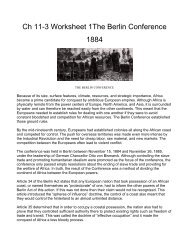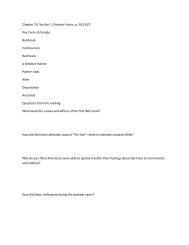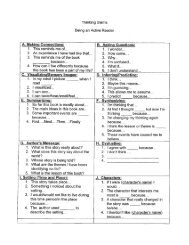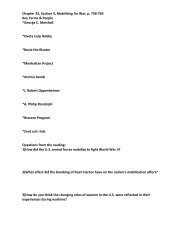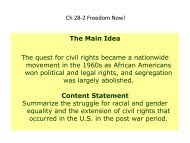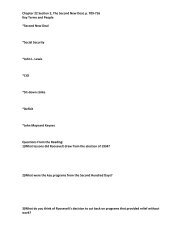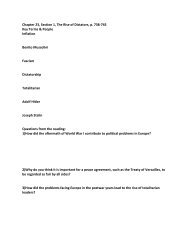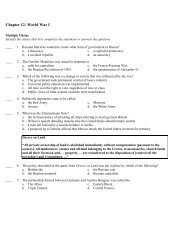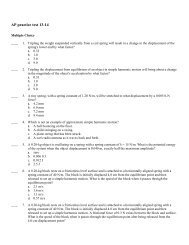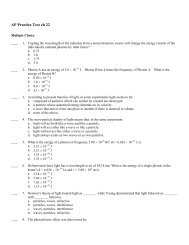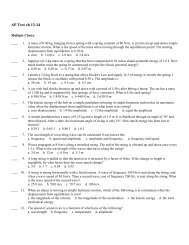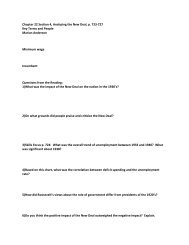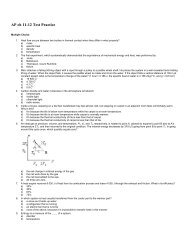Section 1 Enlightenment and Revolution
Section 1 Enlightenment and Revolution
Section 1 Enlightenment and Revolution
You also want an ePaper? Increase the reach of your titles
YUMPU automatically turns print PDFs into web optimized ePapers that Google loves.
<strong>Enlightenment</strong> <strong>and</strong> <strong>Revolution</strong><br />
<strong>Section</strong> 1
<strong>Enlightenment</strong> <strong>and</strong> <strong>Revolution</strong><br />
<strong>Section</strong> 1
<strong>Enlightenment</strong> <strong>and</strong> <strong>Revolution</strong><br />
<strong>Section</strong> 1<br />
Main Idea<br />
Ch 5.1-- The Scientific <strong>Revolution</strong><br />
New ways of thinking led to remarkable discoveries during the<br />
Scientific <strong>Revolution</strong>.<br />
Content Statement 5 /Learning Goal<br />
Describe how the Scientific <strong>Revolution</strong>’s impact on religious,<br />
political <strong>and</strong> cultural institutions challenged how people viewed<br />
the world.<br />
Content Statement 6/Learning Goal<br />
Describe how <strong>Enlightenment</strong> thinkers applied reason to<br />
discover natural laws guiding human nature in social, political<br />
<strong>and</strong> economic institutions
<strong>Enlightenment</strong> <strong>and</strong> <strong>Revolution</strong><br />
<strong>Section</strong> 1<br />
1)Dawn of Modern Science<br />
Some Middle Ages scholars sought answers about the natural world<br />
from the church.<br />
The Old View<br />
• Scholars relied on traditional<br />
authorities for beliefs of the<br />
universe<br />
• Geocentric theory, Aristotle<br />
– Earth center of universe<br />
– Sun, moon, planets revolved<br />
around earth<br />
• Ideas upheld by church,<br />
accepted authority for<br />
European intellectuals<br />
2)New Viewpoints 1550’s<br />
• Scientific <strong>Revolution</strong>, new<br />
way of thinking, posed<br />
theories, <strong>and</strong> developed<br />
procedures to test ideas<br />
• Why open to new ideas?<br />
– Exploration<br />
– New l<strong>and</strong>s, new people, new<br />
animals
<strong>Enlightenment</strong> <strong>and</strong> <strong>Revolution</strong><br />
<strong>Section</strong> 1<br />
2)New Viewpoints Continued<br />
Ancient scholars could provide no information about<br />
new l<strong>and</strong>s, people, animals<br />
• Age of Exploration led scientists to study natural world<br />
more closely<br />
• Other things to be discovered, things unknown to<br />
ancients<br />
• Navigators needed more accurate instruments,<br />
geographic knowledge<br />
• Scientists examined natural world, found it did not match<br />
ancient beliefs
<strong>Enlightenment</strong> <strong>and</strong> <strong>Revolution</strong><br />
<strong>Section</strong> 1<br />
New Approach to Investigation<br />
3)The Scientific Method<br />
Scientific Method Scholars<br />
• Scientific Method: a set of<br />
techniques for acquiring new<br />
knowledge about the natural<br />
world based on observable,<br />
measurable evidence.<br />
• Identify problem<br />
• Form hypothesis<br />
• Perform experiments to test<br />
hypothesis<br />
• Record results<br />
• Analyze results, form<br />
conclusion<br />
• Two most important scholars in<br />
developing scientific method<br />
were Bacon <strong>and</strong> Descartes<br />
• Francis Bacon, experimentation<br />
to gain scientific knowledge<br />
• Rene Descartes, reason key<br />
• Believed everything should be<br />
doubted until proved by reason<br />
• Relied on math, logic<br />
• Influence modern scientific<br />
methods
<strong>Enlightenment</strong> <strong>and</strong> <strong>Revolution</strong><br />
<strong>Section</strong> 1<br />
p. 171
<strong>Enlightenment</strong> <strong>and</strong> <strong>Revolution</strong><br />
<strong>Section</strong> 1<br />
Discoveries in Astronomy, Physics, <strong>and</strong> Math<br />
Early scientists<br />
• Made significant contributions in astronomy, physics <strong>and</strong> math<br />
4)Copernicus<br />
• Found geocentric theory of movement of sun, moon, planets not accurate<br />
• Heliocentric theory, earth revolves around sun<br />
• Concluded sun, not earth, near center of solar system<br />
• Copernicus developed detailed mathematical explanation of process<br />
• Was first scientist to create complete model of solar system
<strong>Enlightenment</strong> <strong>and</strong> <strong>Revolution</strong><br />
<strong>Section</strong> 1<br />
4) Copernicus Continued<br />
• Copernicus’ famous book not published until last year of his life<br />
• Knew church would oppose work<br />
• Work contradicted teachings of church<br />
Weaknesses of theory<br />
• Mathematical formulas did not predict positions of planets well<br />
• Copernicus did not want to be ridiculed for weaknesses<br />
• Died 1543 after work published, other scientists exp<strong>and</strong>ed on ideas
<strong>Enlightenment</strong> <strong>and</strong> <strong>Revolution</strong><br />
<strong>Section</strong> 1<br />
5)Brahe <strong>and</strong> Kepler<br />
Brahe, Danish Astronomer<br />
• Brahe Discovered a supernova, distant exploding star suddenly<br />
visible on earth<br />
• Book impressed Denmark’s King Frederick II<br />
• Gave Brahe money to build two observatories<br />
Observations<br />
• Developed system to explain<br />
planetary movement<br />
• Believed sun revolved around earth<br />
• Other five known planets revolved<br />
around sun<br />
Kepler, German<br />
Mathematician<br />
• Hired as Brahe’s assistant to form<br />
mathematical theory from<br />
measurements of planets<br />
• Published result of measurements<br />
of orbit of Mars after Brahe’s death
<strong>Enlightenment</strong> <strong>and</strong> <strong>Revolution</strong><br />
<strong>Section</strong> 1<br />
5) Kepler, German Mathematician<br />
• Brahe’s assistant<br />
• Kepler solved main problem of Copernican theory<br />
• Copernicus assumed planets orbited in circle<br />
• Kepler found assumption untrue<br />
• Proved planets orbited in oval pattern, ellipse<br />
• Wanted to prove Copernicus wrong, instead proved<br />
heliocentric theory correct<br />
• Kepler’s mathematical solar system model also correct
<strong>Enlightenment</strong> <strong>and</strong> <strong>Revolution</strong><br />
<strong>Section</strong> 1<br />
Discoveries in Astronomy, Physics, <strong>and</strong> Math<br />
6) Galileo Galilei<br />
• Built first telescope used for astronomy<br />
• Craters on moon, sunspots<br />
• Saturn, moons of Jupiter<br />
• Milky Way made up of stars<br />
7)Isaac Newton<br />
• Brought together astronomy, physics, math<br />
• Book explained law of universal gravitation<br />
• Gravity affects objects on earth, also in universe<br />
• Keeps planets in orbit
<strong>Enlightenment</strong> <strong>and</strong> <strong>Revolution</strong><br />
<strong>Section</strong> 1<br />
7)Newton’s Findings<br />
Newton developed calculus, new kind of math<br />
• Used calculus to predict effects of gravity<br />
• German philosopher Gottfried von Leibniz also developed<br />
calculus at same time<br />
• Each accused the other of plagiarism<br />
• Historians believe it was simple case of independent<br />
discovery
<strong>Enlightenment</strong> <strong>and</strong> <strong>Revolution</strong><br />
<strong>Section</strong> 1<br />
8) Science <strong>and</strong> the Church<br />
While the church opposed the views of many scientists, it benefited<br />
from new discoveries that made Renaissance art <strong>and</strong> architecture<br />
possible.<br />
Science <strong>and</strong> the Church<br />
• Church was primary resource<br />
for knowledge, learning<br />
• Cathedral schools, universities<br />
trained people to run the church<br />
Conflicts<br />
• Most scientists did not want to<br />
challenge role of Christianity<br />
• Church explained world through<br />
inspiration, revealed truth<br />
• Science explained world<br />
through logical reasoning<br />
The church feared reason as an enemy of faith, but eventually began to<br />
embrace some of the achievements of the Scientific <strong>Revolution</strong>.
<strong>Enlightenment</strong> <strong>and</strong> <strong>Revolution</strong><br />
<strong>Section</strong> 1<br />
Galileo’s Theories<br />
• Brought him into direct conflict with the church<br />
• Church leaders pressured him not to support ideas of Copernicus<br />
• Dialogue concerning Two Chief World Systems, 1632, showed support<br />
Trial 1633<br />
8)Science <strong>and</strong> the Church<br />
• Pope Urban VII ordered Galileo to Rome to st<strong>and</strong> trial before Inquisition<br />
• Church wanted to stamp out heresy, or dissenting views<br />
House Arrest<br />
• Galileo stated would not use Copernican theory in work in order to receive<br />
more lenient sentence.<br />
• Pope ordered Galileo under house arrest, where he spent rest of life
<strong>Enlightenment</strong> <strong>and</strong> <strong>Revolution</strong><br />
<strong>Section</strong> 1<br />
**Extra** Discoveries in Biology <strong>and</strong> Chemistry<br />
Scientists used the scientific method to acquire new knowledge <strong>and</strong><br />
make great discoveries in the fields of Biology <strong>and</strong> Chemistry.<br />
Vesalius<br />
• Used bodies of<br />
executed criminals<br />
for dissection<br />
• Hired artists to<br />
produce accurate<br />
drawings<br />
• On the Workings of<br />
the Human Body,<br />
1543<br />
William Harvey<br />
• English physician,<br />
early 1600s<br />
• Observed,<br />
explained workings<br />
of human heart<br />
• Described blood,<br />
circulatory system<br />
functions
<strong>Enlightenment</strong> <strong>and</strong> <strong>Revolution</strong><br />
<strong>Section</strong> 1<br />
Antony van Leeuwenhoek, Dutch scientist, 1600s<br />
• Used interest in developing magnifying lens to invent microscope<br />
Robert Hooke, English physician, inventor<br />
• Used early microscope to describe appearance of plants at<br />
microscopic level<br />
• Credited with creating the term cell
<strong>Enlightenment</strong> <strong>and</strong> <strong>Revolution</strong><br />
<strong>Section</strong> 1<br />
Robert Boyle<br />
• Father of modern chemistry<br />
• First to define element<br />
• The Sceptical Chemist, 1661,<br />
described matter as cluster of<br />
tiny particles (now called atoms)<br />
• Changes in matter occurred<br />
when clusters rearranged<br />
Chemistry<br />
Antoine-Laurent Lavoisier<br />
• French chemist, 1700s<br />
• Developed methods for precise<br />
measurements<br />
• Discovered law of Conservation<br />
of Mass, proved matter could<br />
not be created, destroyed<br />
• Recognized, named oxygen,<br />
introduced metric system,<br />
invented first periodic table
<strong>Enlightenment</strong> <strong>and</strong> <strong>Revolution</strong><br />
<strong>Section</strong> 1<br />
Renaissance<br />
Science <strong>and</strong> Art<br />
Artists<br />
• Study of art, architecture not<br />
separate from study of science<br />
• Artists learned anatomy in order<br />
to paint the body<br />
• Experimented with chemistry of<br />
paints, nature of light<br />
• Used math to create<br />
compositions of perfect balance<br />
Architecture<br />
• Mathematics, physics crucial to<br />
great architecture<br />
• Also used in engineering<br />
achievements of the time<br />
Science <strong>and</strong> religion<br />
• Combined to produce great<br />
artistic achievements of<br />
Renaissance<br />
• Most art, architecture dedicated<br />
to glory of God
<strong>Enlightenment</strong> <strong>and</strong> <strong>Revolution</strong><br />
<strong>Section</strong> 1<br />
Science <strong>and</strong> Community Summary<br />
• Scientific <strong>Revolution</strong> established new way of<br />
thinking about physical world<br />
• Great advances made in astronomy, physics, biology,<br />
chemistry<br />
• Advances influenced developments in arts, architecture<br />
• Scientific <strong>Revolution</strong> soon would cause philosophers,<br />
scholars to wonder if reason could solve poverty,<br />
war, ignorance



